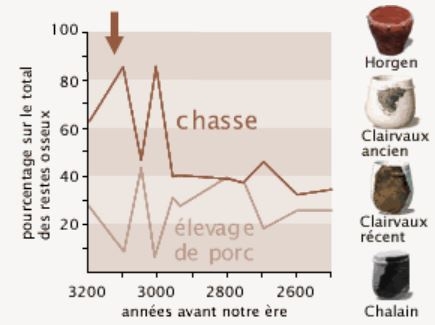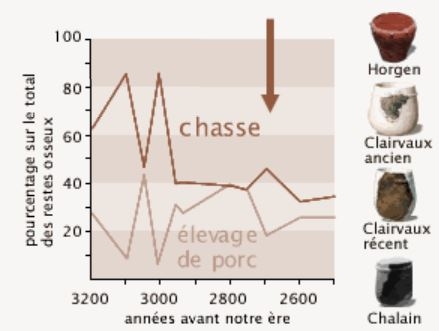Hunting as a reflection of problems in society
In late Neolithic societies, the role of the hunt shifted rapidly from one generation to the next. Game consumption was in reverse proportion to the consumption of domesticated pork.
Everything indicates that hunting was not simply a technical activity for the survival of human groups. Hunting, particularly deer hunting, tended to be given momentum by the arrival of new settlers in the Combe d'Ain. Peaks in game consumption correspond very closely with periods of reciprocal acculturation; in other words, when social problems were exacerbated between two different cultural groups.
Variations of the curve of game, in connection with acculturation between local populations and new settlers.
Drawing by R.M. Arbogast.
Variations of the curve of game, in connection with acculturation between local populations and new settlers.
Drawing by R.M. Arbogast.
Variations of the curve of game, in connection with acculturation between local populations and new settlers.
Drawing by R.M. Arbogast.
Variations of the curve of game, in connection with acculturation between local populations and new settlers.
Drawing by R.M. Arbogast.
Between the supernatural and an expression of power
In fact, the ways in which game was hunted down tends to show that hunting had a particular status, one that went far beyond that of mere food-gathering. Hunting scenes engraved on steles in the Val Camonica, dedicated to supernatural powers, are an indication of this.
Stele of Tirano in the Val Camonica (Italy).
Drawing by S. Casini, 1998.
Another indication is necklaces adorned with the teeth of carnivores (bears, wolves and dogs) and, more frequently, small pierced carnivore bones, mostly dog and wolf, both species being good pack hunters.
Bear and dog teeth, prepared for putting on a collar.
Chalain 2 AC, 30th century BCE.
Pendeloques on small bones of dog and fox.
Chalain 4, 31st century BCE.
Photo: P. Pétrequin.
In addition, the Neolithics sought trophies from the older and larger animals: very large boar's teeth or particularly broad pairs of antlers. With younger animals, trophies were of no importance: antlers from freshly slaughtered young deer were discarded to make it easier to drag the animals back to the village.
Thus, hunting appears to have been a social technique that marked the stages of an adult's life. It was also unquestionably linked to public offerings of quarters of game grilled on heated stones, both for competition between powerful people and to regulate social imbalances.







